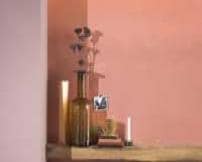
Inspiration
Good to see you!
Welcome to Taubmans
Terms and Conditions
Registration complete
Successfully registered, please login
Registration complete
Forgotten your password?
Please enter email address associated to your account
Change Password
Password changed successfully.
Request sent!
For more tailored inspiration, please fill in the 3 questions below.
Thanks!
We will send you colourful news every now and then.
Delete Account
Give your walls extra edge with these 5 textured paint finishes that feel as good as they look.
“I want to add some texture to my walls but I’m not sure how to go about it. Any tips or techniques you can recommend?”
Smooth finishes are lovely, but if you’re looking for a dramatic paint effect the next time you redecorate, why not consider playing with texture?
Whether you favour rustic roughness, shabby chic, industrial edge or something a little different, there’s a touchable finish to suit your style.
So whether you’re having it done, or doing it yourself, add texture with these five techniques for super-stylish walls that will get your home noticed.
1. Rough it up with sand
Adding sand to paint is an easy and affordable way to give your walls a rough and rustic look. Buy a bag of silica sand from your local hardware store and gradually add it to your paint, stirring regularly and testing the mixture on a sheet of paper as you go until you get the right texture.
Then all you need to do is paint it onto your walls as normal, applying three coats to ensure an even coverage of paint and sand. Warm, earthy hues such as terracotta will lend this technique coarse but cosy feel.
There’s nothing quite like sand to give your walls textural appeal. For a rough and rustic look, try XXX [insert paint product here] – an easy and affordable way to add personality to your walls.
Warm, earthy hues such as terracotta will lend this technique coarse but cosy feel.
Which paints?
E4.28.55 – 90YR 38/239
2. Criss-cross your brush strokes
Paint dries up to 70% lighter than it looks when it’s wet. Criss-crossing your brush strokes is a clever way to take advantage of this, creating a textured finish with natural light and shade.
Use this technique with a dark and moody grey for a cutting-edge industrial look that will really look the part in a modern city apartment.
Which paints?
SN.02.67 – 30BB 45/015
3. Wipe away the years
Shabby chic fans will love this instant aging process for paint, which works particularly well on doors, window frames and woodwork.
Apply a layer of paint in the colour of your choice and leave it to dry completely. Next, paint a different colour over the top of the first layer. If you’ve gone for a darker colour underneath, use a lighter colour on top, and vice versa.
Once the top layer is tacky to the touch, use a damp cloth to wipe away sporadic sections of the paint, revealing streaks of the colour beneath. For a romantic country-style look, use a deep pink for the bottom layer and an ultra-pale pink for the top.
4. Use rags for a royal look
Ragged walls evoke the faded glamour of an ancient palace, and are incredibly easy to achieve.
Simply paint a small section of your wall – half a metre squared is about right – then use an old T-shirt or any cotton rag to daub the wet paint at random, creating a textured pattern of light and dark.
For an extra opulent look, use two colours on the same area, allowing the first coat to dry completely before applying the second. Deep purple and gold make a suitably regal pairing.
Which paints?
S6.11.73 – 10BB 57/115
S7.19.59 – 90BG 38/185
Top tip
Try out the textured technique (or get your decorator to do it) on a sheet of wallpaper underlay so you can see exactly how it will look before you apply it to you walls, and suggest any amendments if needed.
Add a new job
Add a new job
Edit a job
Delete job
Are you sure? All notes, photos and saved items will be deleted.
Save colour
Save to My Workspace
Save product
Save job




